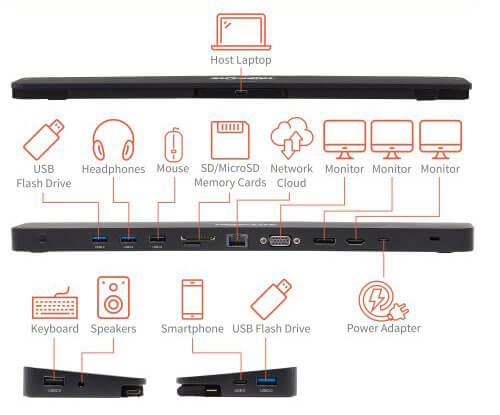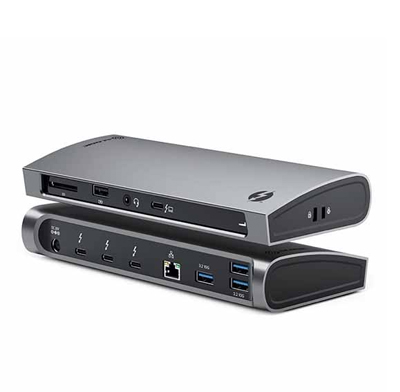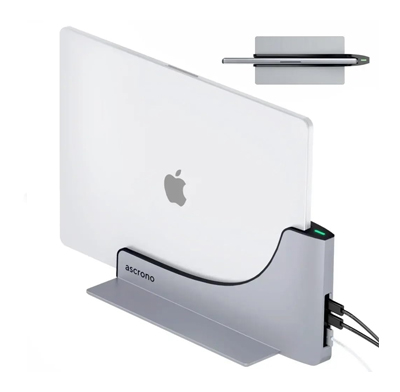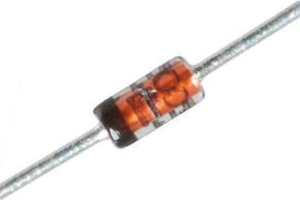Docking Stations Explained: Features, Benefits, and Buying Tips
Author:admin Date: 2025-08-02 03:08 Views:121
導入
Many accessories on the market can improve the performance of your laptop or, sometimes a desktop as well. It all depends on what kind of functionality you want in an accessory. Our focus today is on docking stations. So, what are docking stations, and why would you buy one?
あ docking station is a hardware accessory that expands the functionality of computer systems, such as laptops and tablets, by providing multiple additional ports for peripherals. It can connect monitors, printers, mice, and other devices.
Functions of Docking Stations
それが Dell docking station または an HP docking station, they all have the same functions. Here is what to expect.
Expanding Port Availability
Docking stations can add extra ports to laptops, which often have limited ports because manufacturers want to minimize their size as much as possible.
その docking station for laptops may include USB ports, DisplayPort, or HDMI for connecting monitors, an Ethernet port for wired internet connectivity, card readers, and audio jacks.
As you can see, connecting a wider range of devices will be easier, which would be impossible when you only depend on the ports available on laptops.
Simplified Connections
It is easier when you have a ThinkPad docking station that connects all the peripherals in one place. Imagine if you had to connect all the cables to your laptop. It would lead to clutter, and cables would run from each port. The solution is to have a docking station that allows for better cable management while simplifying the connections.
Enhancing Productivity
Expanding the number of available ports and further simplifying your peripheral connections can show you how such devices can improve productivity.
For example, a docking station can add more monitors and other devices to the working space, providing a larger workspace and improved multitasking capabilities.
A dedicated workstation also allows you to customize it to suit your working needs, especially for people who are doing remote work right now.
Charging and Power Delivery
Docking stations also have power delivery and charging capabilities. This means they can still charge the connected laptop and other devices.
Such a feature eliminates the need for having separate chargers and power adapters. This further declutters the workspace.
Facilitates Presentation
Docking stations can also simplify how you connect to projectors and related presentation equipment. As such, you can seamlessly switch between presentation modes and reduce the chances of issues as you make your presentations.

Key Components of a Docking Station
Both MacBook docking station そして Lenovo docking station have similar key components. Such include:
Ports for Connectivity
These ports include USB, audio jacks, Ethernet, video output, and other specialized ports.
USB ports are quite standard components of a docking station because many devices can use this type of port. Options such as USB-A and USB-C connect different types of devices.
Video output ports, including HDMI, USB-C、 そして ディスプレイポート, are also available to connect external monitors, allowing for multi-monitor setups.
Depending on the docking station model you buy, some of the specialized ports include Thunderbolt 3, eSATA, and more.

Power Delivery Module
The laptop docking station can also come with a charging module that provides power to the connected peripherals and the laptop. The design may expand the docking station’s functionality in terms of charging devices. Yes, some might have dedicated power outlets.
Controller Chips
Docking stations will also have controller chips for managing their various functions, including port connections, data transfer, and power delivery.
The best part about modern docking stations is that they feature a driverless setup. This allows for a plug-and-play experience, as you do not need to install drivers manually.
Some docking stations even have buttons that replicate what is on the laptop. For example, you can get some that can power on or off the laptop from the docking station.
Other Key Features
It is possible to include security features in docking stations. Examples include fingerprint scanners that provide the best security while accessing your devices.
Still, docking stations can have mechanisms to protect against outages and power surges.
Types of Docking Stations
There can be many ways of categorizing docking stations. Below is a common way of understanding the different types of docking stations in the market.
1. USB-C Docking Stations
Examples include the Anker docking station そして Dell laptop docking station. These docking stations are popular because the USB-C port is now common in many laptops and smartphones. The result is a wide range of device connectivity compared to the other types in the market.

2. Thunderbolt Docking Stations
Expect to find such a docking station with Apple devices. This is because they have the Thunderbolt interface, which allows high-speed data transfer and supports multiple high-resolution displays.
Thunderbolt is available on Apple devices and other laptop brands. However, you may have to pay more for a laptop with such an interface and the docking station too.

3. Universal Docking Stations
Such docking stations are built to work with different laptop and smartphone brands. Some may need driver installation to perform optimally, while others are simply plug-and-play devices.
Overall, users who handle multiple devices or who constantly switch between different laptops will get the best flexibility and versatility.

4. Proprietary Docking Station
Specific laptop manufacturers design and sell docking stations, such as the MacBook Pro docking station, a docking station for HP or Dell, and more.
They are built to help users seamlessly integrate if they own devices made by the same manufacturer. Custom features and software can integrate well with the devices connected to them.

Who Needs Docking Stations?
Anyone can get a USB-C docking station if the need arises. For example, you want to work as a remote worker with multiple screens and connect various peripheral devices. Well, having a docking station makes your work easier. You can connect different devices to your laptop and seamlessly transition from working in the office to working at home.
We also see it as a good addition for those who want to increase their productivity. That is the whole point of having multiple devices, such as monitors, keyboards, and mice, all connected in one place.
How about you just want an expanded workspace? Yes, docking stations can come in handy to support multiple external monitors. This gives you more workspace to handle your work. You can also connect a wide range of peripherals such as hard drives, audio devices, and printers.
These are those who want a cleaner desk free from clutter. We expect them to use docking stations to help with cable management.
How to Choose the Right Docking Station
1. Compatibility
The last thing you need is an HP laptop docking station that is incompatible with your Lenovo laptop. So, ensure the laptop model and docking stations are compatible to communicate and make your work easier.
Sometimes, your operating system can affect how the docking station works. As such, check operating system compatibility as well.
The port type used to connect to your laptop must also be compatible. Consider a scenario where the docking stations connect via Thunderbolt, but your laptop does not have one. So, pick a docking station with the right port to connect to your laptop.
2. Display Needs
Start by deciding the number of external monitors you want to connect. The number of monitors you can connect via a docking station can be limited.
Also, look at the resolution and refresh rate to ensure the docking station can support your monitors’ desired resolutions and refresh rates.
The availability of video output ports such as HDMI, DVI, or DisplayPort is also important.
3. Port Needs
Having the right number and type of ports to support the peripheral devices is important. Look at the number and type of USB ports since many peripherals may connect via such an interface.
Consider the other ports as well. Such include Ethernet, audio jacks, and SD readers.
It would be better if the docking station supported power delivery. So, make sure it can meet your laptop’s power delivery requirements and still handle the other peripherals connected to it.
4. Budget
Different docking stations will have different prices. It is key to set a budget for a docking station and see what you get for it. Sometimes, it might be necessary to adjust the budget to get high-quality docking stations. Make sure to always go for value for money.
5. Brand Reputation
Buying docking stations from top brands such as Lenovo, HP, Apple, Dell, and others often assures you of top-quality products. Take the time to read more about the specific docking station to see if it will give you the performance you are looking for. It might not be a big brand, but it may still deliver on the features you want.
How to Set Up Docking Stations
The setup process is quite simple. Here is what to do:
- Check the docking station compatibility
- Gather your peripherals and necessary cables
- Find a suitable location for your docking station
- Connect the docking station’s power adapter to the power outlet
- Connect the docking station to your laptop. Depending on the laptop, it could use the USB-C port, Thunderbolt port, or any other proprietary port.
- Add any drivers if they are needed, but for some, they are plug and play
- Once the docking station is connected to the laptop, start connecting the peripherals, including monitors, keyboards, and mice.
Common Issues and Fixes of Docking Stations
Some common issues you might face while using a docking station include connection, display, power, driver, or firmware issues, network connectivity issues, and physical issues.
Connection problems occur when the devices connected to the docking station are not recognized. The issue could be intermittent, or the docking station needs to be replaced.
時々、 dual monitor docking station might have display issues. This is where the monitors display “No Signal”, flickering, or distorted images. Check to see if the cables are plugged in correctly. A tight and secure connection gives you the best video display.
Outdated or incompatible drivers may cause driver or firmware issues. Update the drivers so that you have the right ones to run the docking station.
Physical issues such as damaged cables or loose hardware may also lead to performance problems. If you notice one, assess whether you will repair or replace the docking station.
Alternatives to Docking Stations
Docking stations are good at what they do, but you can still get alternatives depending on your needs. Here is a quick list of alternatives.
- USB-C Hubs – these are smaller but more portable than docking stations. They will have a range of USB ports. They are generally good for someone who only needs a few extra ports.
- Multiport Adapters – they are similar to hubs and will offer a variety of ports. They are usually more compact and tailored to specific applications.
- USB Display Adapters – these are for those who need to connect multiple monitors. They can be used in conjunction with the hubs or multiport adapters to get the display options.
結論
Docking stations are important for expanding the functionality of your tablet or sometimes a desktop by providing additional ports for connecting your devices. We have seen the many types available and how you can choose one. Buying from a top brand is always recommended to end up with high-quality docking stations. Also, only choose one after doing enough research to find the best model with the right value for the money.
Video: Using a Docking Station
RFQ をお送りください。すぐに対応させていただきます。
よくある質問
Is a USB hub the same as a docking station?
No. A USB hub simply offers additional USB ports, but a docking station provides video outputs as well, among other ports. This includes audio jacks, SD card slots, Ethernet ports, and others.
Can you use a docking station with a MacBook?
Yes. Many docking stations have USB-C and Thunderbolt connectivity options. Also, most come with drivers that work with macOS to ensure the best functionality.
How many monitors can you connect to a docking station?
Most docking stations allow you to connect up to 2 external monitors. However, some advanced models can handle 3 or 4 monitors, depending on the graphics capabilities and the docking station specification.


